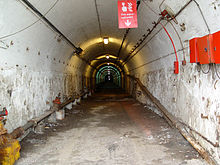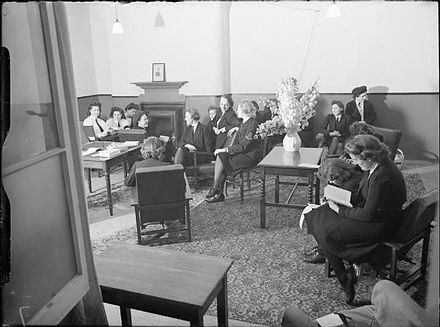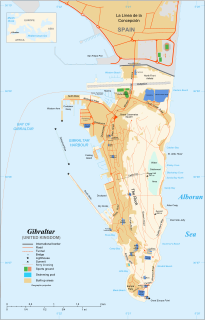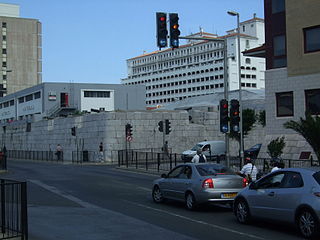
USS Dwight D. Eisenhower (CVN-69) is a nuclear-powered aircraft carrier currently in service with the United States Navy. Commissioned in 1977, the ship is the second of the ten Nimitz-class aircraft carriers currently in service, and is the first ship named after the 34th President of the United States, Dwight D. Eisenhower. The vessel was initially named simply as USS Eisenhower, much like the lead ship of the class, Nimitz, but the name was changed to its present form on 25 May 1970. The carrier, like all others of her class, was constructed at Newport News Shipbuilding Company in Virginia, with the same design as the lead ship, although the ship has been overhauled twice to bring her up to the standards of those constructed more recently.
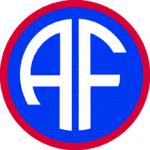
Allied Force Headquarters (AFHQ) was the headquarters that controlled all Allied operational forces in the Mediterranean Theatre of World War II from late 1942 until the end of the war in Europe in May 1945.

RAF Gibraltar is a Royal Air Force station on Gibraltar. No military aircraft are currently stationed there, but RAF, Commonwealth and aircraft of other NATO nations will periodically arrive for transient stopovers, exercises, or other temporary duty. Administered by British Forces Gibraltar, the station is a joint civil-military facility that also functions as the Rock's civilian airport – Gibraltar Airport, with the civilian airport's passenger terminal building and apron facilities located on the north side of the runway while the apron and hangar of RAF Gibraltar are located on the south side of the runway.

Wichita Dwight D. Eisenhower National Airport is a commercial airport 7 miles (11 km) west of downtown Wichita, Kansas. It is the largest and busiest airport in the state of Kansas. ICT covers 3,248 acres.

Admiral Sir Harold Martin Burrough was a senior Royal Navy officer and Assistant Chief of Naval Staff to the Royal Navy during World War II.

HSC-7 Helicopter Sea Combat Squadron Seven, also known as the Dusty Dogs, is a United States Navy helicopter squadron located at Naval Station Norfolk. They are attached to Carrier Air Wing Three and deploy aboard USS Dwight D. Eisenhower.

The military history of Gibraltar during World War II exemplifies Gibraltar's position as a British fortress since the early 18th century and as a vital factor in British military strategy, both as a foothold on the continent of Europe, and as a bastion of British sea power. During World War II, Gibraltar served a vital role in both the Atlantic Theatre and the Mediterranean Theatre, controlling virtually all naval traffic into and out of the Mediterranean Sea from the Atlantic Ocean.
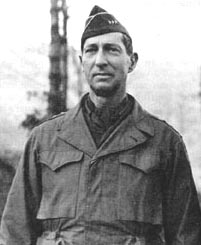
Operation Flagpole was part of the run-up to Operation Torch, the planned Allied invasion of North Africa during World War II. It involved arranging for and carrying out a top-secret high-level meeting between U.S. General Mark W. Clark, representing the Allies, and Général Charles E. Mast, the leader of a group of pro-Allied Vichy France officers in French North Africa, to secure their cooperation with the invasion.

Parson's Lodge Battery is a coastal battery and fort in the British Overseas Territory of Gibraltar.

The Royal Naval Hospital Gibraltar , formerly the British Military Hospital Gibraltar , was a military hospital founded c. 1903 to provide healthcare for British military personnel and local sailors. The facility, located on Europa Road in the British Overseas Territory of Gibraltar's South District, comprised three buildings. The hospital was transferred to the Royal Navy in 1963. It closed in 2008, and underwent residential conversion that began prior to the hospital's closure.

The American War Memorial is a World War I memorial in the British Overseas Territory of Gibraltar. It was built for the American Battle Monuments Commission in 1933, and incorporated into the main city wall, the Line Wall Curtain. It commemorated the successful alliance of the United States and the United Kingdom in their naval exploits in the vicinity of Gibraltar during the Great War. The monument was inaugurated in 1937. Sixty-one years later, in November 1998, the monument was the site of another unveiling ceremony, that of a bronze plaque which commemorated the World War II Allied invasion of North Africa, Operation Torch. That unveiling ceremony was one of a number of events that weekend whose guests included dignitaries from the United Kingdom and the United States.
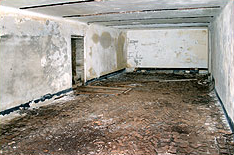
Operation Tracer was a secret Second World War military operation in Gibraltar, a British colony and military base. The impetus for the plan was the 1940 scheme by Germany to capture Gibraltar, code-named Operation Felix. Operation Tracer was the brainchild of Rear Admiral John Henry Godfrey, the Director of the Naval Intelligence Division of the Admiralty.

Signal Hill Battery or Signal Battery was an artillery battery in the British Overseas Territory of Gibraltar. The battery was mounted high on the rock. Little remains today as the Gibraltar Cable Car top station was built on the site of the old battery.

The Great North Road is a large road tunnel in the British Overseas Territory of Gibraltar. It was constructed by the British military during World War II inside the Rock of Gibraltar and remains property of the Ministry of Defence to this day. The road allowed lorries to travel from the north to the south of Gibraltar entirely within the Rock. The tunnel still contains the remains of World War II buildings such as Nissen huts, kitchens, offices as well as a generating station and period anti-submarine nets.

The tunnels of Gibraltar were constructed over the course of nearly 200 years, principally by the British Army. Within a land area of only 2.6 square miles (6.7 km2), Gibraltar has around 34 miles (55 km) of tunnels, nearly twice the length of its entire road network. The first tunnels, excavated in the late 18th century, served as communication passages between artillery positions and housed guns within embrasures cut into the North Face of the Rock. More tunnels were constructed in the 19th century to allow easier access to remote areas of Gibraltar and accommodate stores and reservoirs to deliver the water supply of Gibraltar.
Operation Kingpin was part of the run-up to Operation Torch, the planned Allied invasion of North Africa during World War II. It was a successor to Operation Flagpole, in which a secret meeting between U.S. General Mark W. Clark and diplomat Robert Murphy, representing the Allies, and General Charles E. Mast, the leader of a group of pro-Allied Vichy France officers in French North Africa, was arranged to secure their cooperation with the invasion. In Operation Kingpin, French General Henri Giraud, code-named "Kingpin", was released from confinement and brought to Gibraltar to meet with Operation Torch commander General Dwight D. Eisenhower and Clark in order to secure his cooperation with the invasion.
Orange One is a U.S. Navy–operated facility located in the Appalachian Mountains, extending underneath Camp David, the U.S. President's country retreat. Described in one account as a "fortress", it was designed for use by the president as a military headquarters during an emergency.
